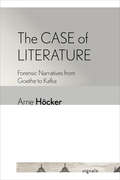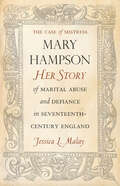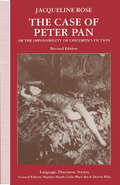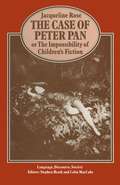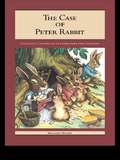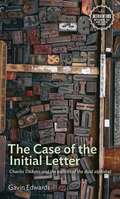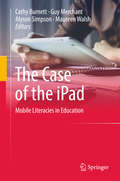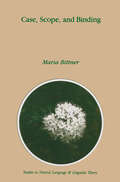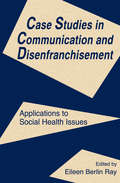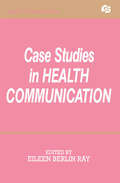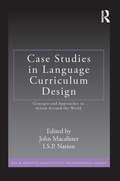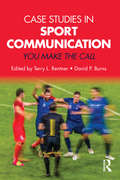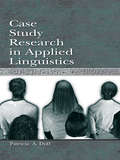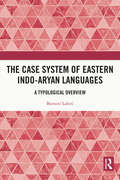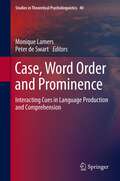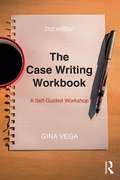- Table View
- List View
The Case of Literature: Forensic Narratives from Goethe to Kafka (Signale: Modern German Letters, Cultures, and Thought)
by Arne HöckerIn The Case of Literature, Arne Höcker offers a radical reassessment of the modern European literary canon. His reinterpretations of Goethe, Schiller, Büchner, Döblin, Musil, and Kafka show how literary and scientific narratives have determined each other over the past three centuries, and he argues that modern literature not only contributed to the development of the human sciences but also established itself as the privileged medium for a modern style of case-based reasoning.The Case of Literature deftly traces the role of narrative fiction in relation to the scientific knowledge of the individual from eighteenth-century psychology and pedagogy to nineteenth-century sexology and criminology to twentieth-century psychoanalysis. Höcker demonstrates how modern authors consciously engaged casuistic forms of writing to arrive at new understandings of literary discourse that correspond to major historical transformations in the function of fiction. He argues for the centrality of literature to changes in the conceptions of psychological knowledge production around 1800; legal responsibility and institutionalized forms of decision-making throughout the nineteenth century; and literature's own realist demands in the early twentieth century.
The Case of Mistress Mary Hampson: Her Story of Marital Abuse and Defiance in Seventeenth-Century England
by Jessica MalayThe centerpiece of The Case of Mistress Mary Hampson is the autobiographical narrative of a 17th-century woman in an abusive and violent marriage. Composed at a time when marital disharmony was in vogue with readers and publishers, it stands out from comparable works, usually single broadsheets. In her own words, Mary recounts various dramatic and stressful episodes from her decades-long marriage to Robert Hampson and her strategies for dealing with it. The harrowing tale contains scenes of physical abuse, mob violence, abandonment, flight, and destitution. It also shows moments of personal courage and interventions on the author's behalf by friends and strangers, some of whom are subject to severe reprisals. Mary wrote her story to come to terms with her situation, to justify her actions, and to cast herself in a virtuous light. The accompanying discussion of her life, drawn from other sources, provides chilling evidence of the vulnerability of seventeenth-century women and the flawed legal mechanisms that were supposed to protect them. Readers are also invited to consider in what ways the self-portrait is accurate and what elements of it may be considered fabrication. Malay's archival efforts have thus rescued a compelling and complicated voice from the past.
The Case of Peter Pan: or The Impossibility of Children's Fiction (Language, Discourse, Society)
by Jacqueline RoseWhat does Peter Pan have to say about our conception of childhood, about how we understand the child's and our own relationship to language, sexuality, and death? What can Peter Pan tell us about the theatrical, literary, and educational institutions of which it is a part? In a new preface written especially for this edition, Rose accounts for some of the new developments since her book's first publication in 1984. She discusses some of Peter Pan's new guises and their implications. From Spielberg's Hook, to the lesbian production of the play at the London Drill Hall in 1991, to debates in the English House of Lords, to a newly claimed status as the icon of a transvestite culture, Peter Pan continues to demonstrate its bizarre renewability as a cultural fetish of our times.
The Case of Peter Pan or the Impossibility of Children's Fiction: Or The Impossibility Of Children's Fiction (Language, Discourse, Society)
by Jacqueline RoseThe Case of Peter Rabbit: Changing Conditions of Literature for Children (Children's Literature and Culture #7)
by Margaret MackeyFirst published in 1998. Routledge is an imprint of Taylor & Francis, an informa company.
The Case of Peter Rabbit: Changing Conditions of Literature for Children (Children's Literature and Culture)
by Margaret MackeyFirst published in 1998. Routledge is an imprint of Taylor & Francis, an informa company.
The Case of the Initial Letter: Charles Dickens and the politics of the dual alphabet (Interventions: Rethinking the Nineteenth Century)
by Gavin EdwardsThe book analyses attempts by Dickens and other nineteenth-century writers to challenge established ways of using the distinction between upper and lower case letters, in the interests of a wider radicalism. It discusses Dickens’s satire - on ‘Shares’ in Our Mutual Friend, on Paul Dombey’s position as the ‘Son’ of Dombey and Son - alongside the proto-modernist typography of suffragist poet Augusta Webster and the work of Marx’s translators transforming German conventions of capitalisation into English under the influence of Dickens and Carlyle. Placing these innovations within the history of the dual alphabet from its invention by Carolingian scribes to its rejection by modernist poets and the Bauhaus printers, the book tracks the dual alphabet through Dickens’s manuscripts, corrected proofs, and the ‘prompt copies’ for his public Readings, highlighting distinct ways in which writing, printing and speech produce meaning.
The Case of the Initial Letter: Charles Dickens and the politics of the dual alphabet (Interventions: Rethinking the Nineteenth Century)
by Gavin EdwardsThe book analyses attempts by Dickens and other nineteenth-century writers to challenge established ways of using the distinction between upper and lower case letters, in the interests of a wider radicalism. It discusses Dickens’s satire - on ‘Shares’ in Our Mutual Friend, on Paul Dombey’s position as the ‘Son’ of Dombey and Son - alongside the proto-modernist typography of suffragist poet Augusta Webster and the work of Marx’s translators transforming German conventions of capitalisation into English under the influence of Dickens and Carlyle. Placing these innovations within the history of the dual alphabet from its invention by Carolingian scribes to its rejection by modernist poets and the Bauhaus printers, the book tracks the dual alphabet through Dickens’s manuscripts, corrected proofs, and the ‘prompt copies’ for his public Readings, highlighting distinct ways in which writing, printing and speech produce meaning.
The Case of the iPad: Mobile Literacies in Education
by Cathy Burnett Guy Merchant Alyson Simpson Maureen WalshThis book brings together an international group of literacy studies scholars who have investigated mobile literacies in a variety of educational settings. Approaching mobility from diverse theoretical perspectives, the book makes a significant contribution to how mobile literacies, and tablets in particular, are being conceptualised in literacy research. The book focuses on tablets, and particularly the iPad, as a prime example of mobile literacies, setting this within the broader context of literacy and mobility.The book provides inspiration and direction for future research in mobile literacies, based upon 16 chapters that investigate the relationship between tablets and literacy in diverse ways. Together they address the complex and multiple forces associated with the distribution of the technologies themselves and the texts they mediate, and consider how apps, adults and children work together as iPads enter the mesh of practices and material arrangements that constitute the institutional setting.
Case, Scope, and Binding (Studies in Natural Language and Linguistic Theory #30)
by M. BittnerCase, Scope, and Binding investigates the relation between syntax and semantics within a framework which combines the syntactic Government-Binding theory with a novel cross-linguistic theory of case and semantics. It is argued that case assignment, agreement, syntactic binding relations, as well as the minimum scopes of operators, are all determined by the relations which hold at the level of s-structure. Cross-linguistic variation with respect to these phenomena is due to corresponding variations at the s-structure level. The minimum scope of an operator cannot exceed its c-command domain at s-structure, but may be reduced by certain semantic mechanisms. The availability of any wider scope option depends on the possibility of movement at LF. The proposed theory is tested in detail against the facts of Inuit (Eskimo-Aleut family), an ergative language with typologically unusual scope and binding relations. For linguists and philosophers interested in syntax, semantics, or the syntax-semantics interface.
Case Studies in Communication and Disenfranchisement: Applications To Social Health Issues
by Eileen Berlin RaySee blurb for Communication and Disenfranchisement. Books will be promoted together.
Case Studies in Communication and Disenfranchisement: Applications To Social Health Issues
by Eileen Berlin RaySee blurb for Communication and Disenfranchisement. Books will be promoted together.
Case Studies in Health Communication: A Case Study Approach (Routledge Communication Series)
by Eileen Berlin RayThis book focuses on the complexities of the communication of health-related messages and information through the use of case studies. The expert contributors to this volume are scholars who, during their research and consulting, grapple with many of the issues of concern to those studying health communication. While several introductory books offer brief case studies to illustrate concepts covered, this book provides in-depth cases that enable more advanced students to apply theory to real situations.
Case Studies in Health Communication (Routledge Communication Series)
by Eileen Berlin RayThis book focuses on the complexities of the communication of health-related messages and information through the use of case studies. The expert contributors to this volume are scholars who, during their research and consulting, grapple with many of the issues of concern to those studying health communication. While several introductory books offer brief case studies to illustrate concepts covered, this book provides in-depth cases that enable more advanced students to apply theory to real situations.
Case Studies in Language Curriculum Design: Concepts and Approaches in Action Around the World (ESL & Applied Linguistics Professional Series)
by John Macalister I.S.P. NationCase studies are a powerful pedagogical tool for illuminating constructs and models in real-life contexts. Covering a wide range of teaching-learning contexts and offering in-depth analyses of ESL/ELT language curriculum design issues, this casebook is distinctive and unique in that each case draws on and is clearly linked to a single model presented in Nation and Macalister’s Language Curriculum Design (www.routledge.com/9780415806060), giving the book a high degree of coherence. A short commentary by the editors after each case highlights features of note and/or issues arising from it. This is a versatile text, designed to work as a companion to Language Curriculum Design (adding meaning and depth to the model presented there by relating it to a range of applications), as a stand-alone text, or as a resource for language teacher trainees, teacher educators, practicing teachers, program administrators, and materials writers in the field.
Case Studies in Language Curriculum Design: Concepts and Approaches in Action Around the World (ESL & Applied Linguistics Professional Series)
by John Macalister I.S.P. NationCase studies are a powerful pedagogical tool for illuminating constructs and models in real-life contexts. Covering a wide range of teaching-learning contexts and offering in-depth analyses of ESL/ELT language curriculum design issues, this casebook is distinctive and unique in that each case draws on and is clearly linked to a single model presented in Nation and Macalister’s Language Curriculum Design (www.routledge.com/9780415806060), giving the book a high degree of coherence. A short commentary by the editors after each case highlights features of note and/or issues arising from it. This is a versatile text, designed to work as a companion to Language Curriculum Design (adding meaning and depth to the model presented there by relating it to a range of applications), as a stand-alone text, or as a resource for language teacher trainees, teacher educators, practicing teachers, program administrators, and materials writers in the field.
Case Studies in Sport Communication: You Make the Call
by Terry L. Rentner David P. BurnsCase Studies in Sport Communication: You Make the Call goes beyond the box scores by offering readers the opportunity to evaluate popular and diverse issues in sport—including management, crisis, health, ethics, gender, race, and social media. Each chapter incorporates theory and communication principles as well as topical background information, and concludes with discussion questions and engaging assignments. This volume presents real-life, provocative sports cases that bring contemporary headlines into perspective and inspire critical thinking. Each chapter features scholarly evidence that will keep the conversation lively, thoughtful, and informative. Students are encouraged to challenge the ethical implications of what they have read and to “make the call.” This is an invaluable resource for upper-level undergraduate and graduate students of sport communication and sport management.
Case Studies in Sport Communication: You Make the Call
by Terry L. Rentner David P. BurnsCase Studies in Sport Communication: You Make the Call goes beyond the box scores by offering readers the opportunity to evaluate popular and diverse issues in sport—including management, crisis, health, ethics, gender, race, and social media. Each chapter incorporates theory and communication principles as well as topical background information, and concludes with discussion questions and engaging assignments. This volume presents real-life, provocative sports cases that bring contemporary headlines into perspective and inspire critical thinking. Each chapter features scholarly evidence that will keep the conversation lively, thoughtful, and informative. Students are encouraged to challenge the ethical implications of what they have read and to “make the call.” This is an invaluable resource for upper-level undergraduate and graduate students of sport communication and sport management.
Case Study Research in Applied Linguistics
by Patricia DuffCase studies of individual language learners are a valuable means of illustrating issues connected with learning, using, and in some cases, losing another language. Yet, even though increasing numbers of graduate students and scholars conduct research using case studies or mix quantitative and qualitative methods, there are no dedicated applied linguistics research methods texts that guide one through the case study process. This book fills that gap. The volume provides an overview of case study methodology and examples of published case studies in applied linguistics, without attempting to be a comprehensive survey of the innumerable case studies that exist. The case studies presented here involve teachers and learners of English and various other languages in North America and other parts of the world. Advice is also given about how to conduct and publish case studies. Case Study Research in Applied Linguistics is designed for students, both undergraduate and graduate, as well as other scholars seeking to understand case study methods and their applications in research on language learners and language users in a variety of contexts. Applied linguists working in other subfields will find the volume useful in their own research and in their supervision and evaluation of others' case studies.
Case Study Research in Applied Linguistics (Second Language Acquisition Research Ser.)
by Patricia DuffCase studies of individual language learners are a valuable means of illustrating issues connected with learning, using, and in some cases, losing another language. Yet, even though increasing numbers of graduate students and scholars conduct research using case studies or mix quantitative and qualitative methods, there are no dedicated applied lin
The Case System of Eastern Indo-Aryan Languages: A Typological Overview
by Bornini LahiriThis book presents a typological overview of the case system of Eastern Indo-Aryan (EIA) languages. It utilises a cognitive framework to analyse and compare the case markers of seven EIA languages, namely Angika, Asamiya, Bhojpuri, Bangla, Magahi, Maithili and Odia. The book introduces semantic maps, which had hitherto not been used for Indian languages, to plot the scope of different case markers and facilitate cross-linguistic comparison of these languages. It also offers a detailed questionnaire specially designed for fieldwork and data collection which will be extremely useful to researchers involved in the study of ‘case’. A unique look into the linguistic traditions of South Asia, the book will be indispensable to academicians, researchers, and students of language studies, linguistics, literature, cognitive science, psychology, language technologies and South Asian studies. It will also be useful for linguists, typologists, grammarians and those interested in the study of Indian languages.
The Case System of Eastern Indo-Aryan Languages: A Typological Overview
by Bornini LahiriThis book presents a typological overview of the case system of Eastern Indo-Aryan (EIA) languages. It utilises a cognitive framework to analyse and compare the case markers of seven EIA languages, namely Angika, Asamiya, Bhojpuri, Bangla, Magahi, Maithili and Odia. The book introduces semantic maps, which had hitherto not been used for Indian languages, to plot the scope of different case markers and facilitate cross-linguistic comparison of these languages. It also offers a detailed questionnaire specially designed for fieldwork and data collection which will be extremely useful to researchers involved in the study of ‘case’. A unique look into the linguistic traditions of South Asia, the book will be indispensable to academicians, researchers, and students of language studies, linguistics, literature, cognitive science, psychology, language technologies and South Asian studies. It will also be useful for linguists, typologists, grammarians and those interested in the study of Indian languages.
Case, Word Order and Prominence: Interacting Cues in Language Production and Comprehension (Studies in Theoretical Psycholinguistics #40)
by Monique Lamers and Peter de SwartLanguage users have access to several sources of information during the build up of a meaningful construction. These include grammatical rules, situational knowledge, and general world knowledge. A central role in this process is played by the argument structure of verbs, which establishes the syntactic and semantic relationships between arguments. This book provides an overview of recent psycholinguistic and theoretical investigations on the interplay between structural syntactic relations and role semantics. The focus herein lies on the interaction of case marking and word order with semantic prominence features, such as animacy and definiteness. The interaction of these different sorts of information is addressed from theoretical, time-insensitive, and incremental perspectives, or a combination of these. Taking a broad cross-linguistic perspective, this book bridges the gap between theoretical and psycholinguistic approaches to argument structure.
The Case Writing Workbook: A Self-Guided Workshop
by Gina VegaThis book offers a modular set of chapters that focus specifically on the challenges related to case writing. Exercises, worksheets, and training activities help guide readers sequentially through the entire process of writing both a case and an instructor’s manual (teaching note). Designed as an individualized workshop to assist case authors to structure their writing, this book combines the easy-to-understand, student-focused language of the first edition with new material covering the latest developments and challenges in the world of case writing. These include: ? A section on writing cases in condensed time frames ? A new module on writing short cases in various formats ? A new module on turning research papers into teaching tools ? A section about growing communities of practice in a university ? An expansion of the student case writing module to include a section on case writing for graduate students ? Twelve new worksheets ? A complete index to facilitate use of the book Finishing all the book’s assignments will result in a complete case and instructor’s manual that can be tested in the classroom and submitted to a conference or journal. The Case Writing Workbook is a must for the shelf of any academic or student conducting qualitative research and looking to enhance their skill set.
The Case Writing Workbook: A Self-Guided Workshop
by Gina VegaThis book offers a modular set of chapters that focus specifically on the challenges related to case writing. Exercises, worksheets, and training activities help guide readers sequentially through the entire process of writing both a case and an instructor’s manual (teaching note). Designed as an individualized workshop to assist case authors to structure their writing, this book combines the easy-to-understand, student-focused language of the first edition with new material covering the latest developments and challenges in the world of case writing. These include: ? A section on writing cases in condensed time frames ? A new module on writing short cases in various formats ? A new module on turning research papers into teaching tools ? A section about growing communities of practice in a university ? An expansion of the student case writing module to include a section on case writing for graduate students ? Twelve new worksheets ? A complete index to facilitate use of the book Finishing all the book’s assignments will result in a complete case and instructor’s manual that can be tested in the classroom and submitted to a conference or journal. The Case Writing Workbook is a must for the shelf of any academic or student conducting qualitative research and looking to enhance their skill set.
